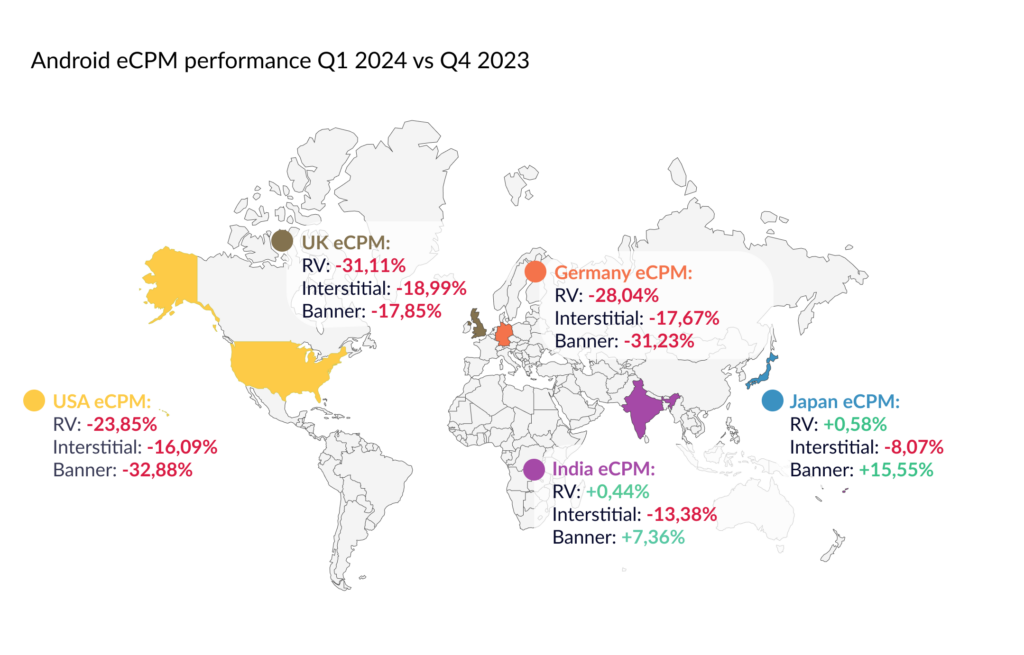
In the constantly evolving world of mobile advertising, app developers must monitor changes and trends in eCPM (effective Cost Per Mille) performance. It’s especially valuable to observe eCPM changes across various countries since they undergo substantial shifts. To help with this task, we prepared a detailed study of Q1 2024 mobile app performance in our mobile apps’ network and dozens of other networks on the demand side and analyzed it in comparison to the previous quarter – Q4 2023. The presented data regards Rewarded Video, Interstitial, and Banner ads for iOS and Android apps in five key markets: the USA, the United Kingdom, Germany, Japan, and India.
It’s vital to comprehend the underlying reasons behind eCPM fluctuations; one of the most obvious ones is seasonality. Developers in Q1 typically see lower ad revenue for apps compared to the quarter before due to reduced advertising budgets following the busy year-end period and significant expenses. However, it’s also important to consider recent developments, such as changes in Google policy. Notably, the company’s transition to real-time bidding auctions for apps, implemented in January 2024, has resulted in fewer multicalls and restricted non-bidding instances to one per waterfall, which also resulted in the change in the rev distribution between different networks and overall revenues.
Mobile apps eCPM performance Q1 2024 vs Q4 2023
The data presented here offers a detailed breakdown of the percentage shifts in mobile app performance during Q1 2024, contrasting with Q4 2023 based on billions of impressions in our network. It’s visually represented on two maps below, one dedicated to Android and the other to iOS, and segmented by different ad formats: Rewarded Video, Interstitial, and Banner:


In general, our analysis indicates a downward trend in eCPM performance for Android apps which is something expected during this time of the year, contrasted with a more optimistic tendency for iOS apps. However, even in this case, decreases are evident across all countries studied. iOS apps monetized in the US, Germany, and Japan saw declines with Banner ads, while in the UK and India, there were additional decreases with RV. India stands out in this study group with the biggest drop of over 45% in Banner ads and a most significant increase of over 41% in Interstitials. Actually, in all countries, Interstitials recorded over 20% growth on iOS, making it an ad format with the highest gains. What’s vital is that the primary factor driving growth on iOS was the strong performance of the bidding networks – Google and AppLovin.
For Android apps, there were only increases observed in India and Japan with Rewarded Video and Banner ads, with the most significant rise in Japan in Banner ads – more than 15%. The most prominent drop occurred in America, with a nearly 33% decrease in Banner ads. In all listed Western countries, we’ve noted a two-digit percentage drop.
It’s important to recognize that the first quarter of the year typically poses challenges for app developers, in opposition to the last one, when consumer spending usually increases, mirroring the rise in campaign budgets. However, this situation often shifts at the beginning of the following year, resulting in drops in ad revenue. Therefore, it’s crucial to make strategic adjustments and take proactive measures to navigate fluctuations in ad performance and revenue generation.
Optimization – the key to a steady growth
Developers of mobile applications need to fine-tune their monetization strategies, especially in the initial quarter of each year, to effectively manage seasonal variations, leverage revenue prospects, and attain their financial goals. One way to achieve this is through cooperation with monetization partners, like Bidlogic, which, among other things, can help automate many tasks like testing the minimum eCPM levels and improving monetization outcomes for specific countries and mediation groups.
